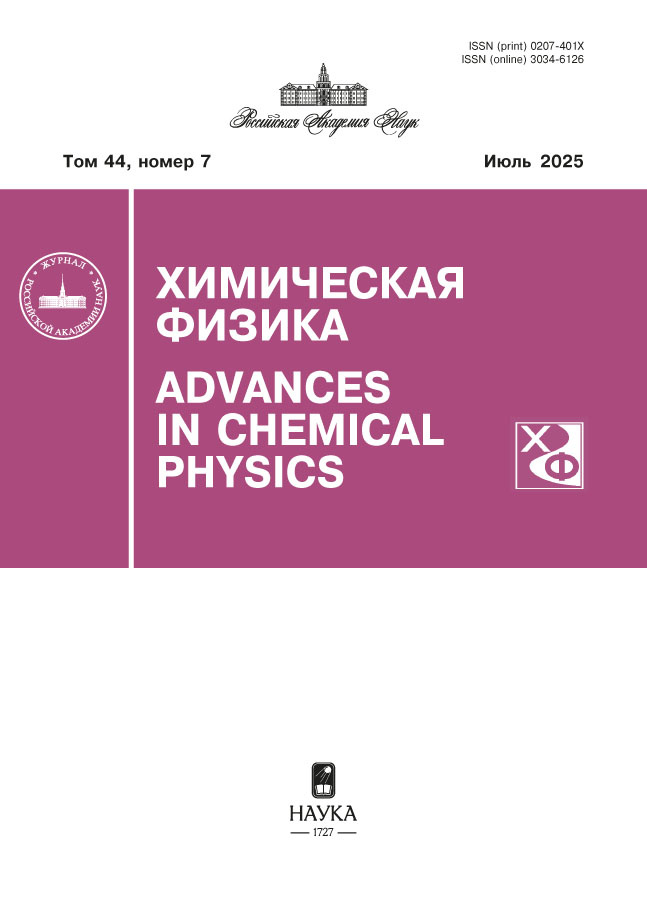Thermodynamic Evaluation of Syngas Production by High-Temperature Conversion of Waste Oil
- Autores: Tsvetkov M.V.1, Podlesny D.N.1, Tsvetkova Y.Y.1, Salganskaya M.V.1, Zaychenko A.Y.1, Kislov V.M.1, Salgansky E.A.1
-
Afiliações:
- Federal Research Center of Problems of Chemical Physics and Medicinal Chemistry of the Russian Academy of Sciences
- Edição: Volume 44, Nº 7 (2025)
- Páginas: 93-99
- Seção: Combustion, explosion and shock waves
- URL: https://ta-journal.ru/0207-401X/article/view/687632
- DOI: https://doi.org/10.31857/S0207401X25070095
- ID: 687632
Citar
Resumo
Thermodynamic evaluation of syngas production by high-temperature conversion of waste oil was performed using the Gibbs free energy minimization method. Optimum conditions for maximum hydrogen production while minimizing coke formation were determined. Equilibrium calculations were performed at atmospheric pressure with varying fuel excess ratio and water vapor amount. The results show that the optimal conditions for air-steam conversion of waste oil are: fuel excess ratio equal to 3.5 and molar ratio of water vapor to oxygen equal to 0.2. Under these conditions, coke formation does not occur, and hydrogen and carbon monoxide concentrations equal 27.5% and 28.4%, respectively.
Palavras-chave
Texto integral
Sobre autores
M. Tsvetkov
Federal Research Center of Problems of Chemical Physics and Medicinal Chemistry of the Russian Academy of Sciences
Autor responsável pela correspondência
Email: tsvetkovmv@gmail.com
Rússia, Chernogolovka
D. Podlesny
Federal Research Center of Problems of Chemical Physics and Medicinal Chemistry of the Russian Academy of Sciences
Email: tsvetkovmv@gmail.com
Rússia, Chernogolovka
Yu. Tsvetkova
Federal Research Center of Problems of Chemical Physics and Medicinal Chemistry of the Russian Academy of Sciences
Email: tsvetkovmv@gmail.com
Rússia, Chernogolovka
M. Salganskaya
Federal Research Center of Problems of Chemical Physics and Medicinal Chemistry of the Russian Academy of Sciences
Email: tsvetkovmv@gmail.com
Rússia, Chernogolovka
A. Zaychenko
Federal Research Center of Problems of Chemical Physics and Medicinal Chemistry of the Russian Academy of Sciences
Email: tsvetkovmv@gmail.com
Rússia, Chernogolovka
V. Kislov
Federal Research Center of Problems of Chemical Physics and Medicinal Chemistry of the Russian Academy of Sciences
Email: tsvetkovmv@gmail.com
Rússia, Chernogolovka
E. Salgansky
Federal Research Center of Problems of Chemical Physics and Medicinal Chemistry of the Russian Academy of Sciences
Email: tsvetkovmv@gmail.com
Rússia, Chernogolovka
Bibliografia
- Holechek J.L., Geli H.M., Sawalhah M.N., Valdez R. // Sustainability. 2022. V. 14. № 8. P. 4792. https://doi.org/10.3390/su14084792
- Tereza A.M., Agafonov G.L., Anderzhanov E.K. et al. // Russ. J. Phys. Chem. B. 2023. V. 17. P. 1294. https://doi.org/10.1134/S1990793123060246
- Aseeva R.M., Kruglov E.Y., Kobelev A.A. et al. // Russ. J. Phys. Chem. B. 2024. V. 18. P. 707. https://doi.org/10.1134/S1990793124700076
- Kalak T. // Energies. 2023. V. 16. № 4. P. 1783; https://doi.org/10.3390/en16041783
- Dorofeenko S., Podlesniy D., Polianczyk E. et al. // Energies. 2024. V. 17. № 23. P. 6093. https://doi.org/10.3390/en17236093
- Li H., Feng Z., Ahmed A.T. et al. // J. Clean. Prod. 2022. V. 334. P. 130230. https://doi.org/10.1016/j.jclepro.2021.130230
- Singhabhandhu A., Tezuka T. // Energy. 2010. V. 35. № 6. P. 2544. https://doi.org/10.1016/j.energy.2010.03.001
- Wang Y., Yang Q., Ke L. et al. // Fuel. 2021. V. 283. 119170. https://doi.org/10.1016/j.fuel.2020.119170
- Lam S.S., Liew R.K., Jusoh A. et al. // Renew. Sustain. Energy Rev. 2016. V. 53. P. 741. https://doi.org/10.1016/j.rser.2015.09.005
- Su G., Ong H.C., Mofijur M., Mahlia T.I., Ok Y.S. // J. Hazard. Mater. 2022. V. 424. P. 127396. https://doi.org/10.1016/j.jhazmat.2021.127396
- Mittelbach M. // Eur. J. Lipid Sci. Technol. 2015. V. 117. № 11. P. 1832. https://doi.org/10.1002/ejlt.201500125
- Widodo S., Ariono D., Khoiruddin K., Hakim A.N., Wenten I.G. // Environ. Prog. Sustain. Energy. 2018. V. 37. № 6. P. 1867. https://doi.org/10.1002/ep.13011
- Zhao N., Li B., Chen D. et al. // Waste Manage. 2020. V. 104. P. 20. https://doi.org/10.1016/j.wasman.2020.01.007
- Akhmetshin M.R., Nyashina G.S., Romanov D.S. // Chem. Petrol. Eng. 2021.V. 56. № 9. P. 846. https://doi.org/10.1007/s10556-021-00851-x
- Chen C.Y., Lee W.J., Mwangi J.K. et al. // Aerosol and Air Qual. Res. 2017. V. 17. № 3. P. 899. https://doi.org/10.4209/aaqr.2016.09.0394
- Kislov V.M., Tsvetkov M.V., Zaichenko A.Y. et al. // Russ. J. Phys. Chem. B. 2023. V. 17. P. 947. https://doi.org/10.1134/S1990793123040255
- Krishenik P.M., Kostin S.V., Rogachev S.A. // Russ. J. Phys. Chem. B. 2023. V. 17. P. 1123. https://doi.org/10.1134/S1990793123050044
- Kislov V.M., Tsvetkova Yu.Yu., Tsvetkov M.V. et al. // Combust., Explos. Shock Waves. 2023. V. 59. № 2. P. 83. https://doi.org/10.15372/FGV20230210
- Toledo M., Arriagada A., Ripoll N., Salgansky E.A., Mujeebu M.A. // Renew. Sustain. Energy Rev. 2023. V. 177. 113213. https://doi.org/10.1016/j.rser.2023.113213
- Salgansky E.A., Tsvetkov M.V., Tsvetkova Y.Y. et al. // Russ. J. Phys. Chem. B. 2022. V. 16. P. 1085. https://doi.org/10.1134/S1990793122060100
- Polianczyk E., Tarasov G., Zaichenko A. // E3S Web Conf. 2024. V. 474. 01013. https://doi.org/10.1051/e3sconf/202447401013
- Tsvetkova Y.Y., Kislov V.M., Pilipenko E.N., Salganskaya M.V., Tsvetkov M.V. // Russ. J. Phys. Chem. B. 2024. V. 18. № 4. P. 980. https://doi.org/10.1134/S199079312470043X
- Arriagada A., Mena R., Ripoll N. et al. // Chem. Eng. J. 2024. V. 495. 153011. https://doi.org/10.1016/j.cej.2024.153011
- Kislov V.M., Tsvetkova Y.Y., Pilipenko E.N. et al. // Russ. J. Phys. Chem. B. 2023. V. 17. № 2. P. 374. https://doi.org/10.1134/S1990793123020070
- Kislov V.M., Glazov S.V., Salgansky E.A., Kolesnikova Yu.Yu., Salganskaya M.V. // Combust. Explos. Shock Waves. 2016. V. 52. № 3. P. 320. https://doi.org/10.1134/S0010508216030102
- Salganskaya M.V., Glazov S.V., Salganskii E.A. et al. // Russ. J. Phys. Chem. B. 2008. V. 2. № 1. P. 71. https://doi.org/10.1134/S1990793108010119
- Rocha C., Soria M.A., Madeira L.M. // J. Energy Inst. 2019. V. 92. № 5. P. 1599. https://doi.org/10.1016/j.joei.2018.06.017
- Noureddine H., Nahla F., Zouhour K., Marie-Noëlle P. // Energy Convers. Manag. 2013. V. 70. P. 174. https://doi.org/10.1016/j.enconman.2013.03.009
- Xu J., Peng Z., Rong S. et al. // Fuel. 2021. V. 306. 121767. https://doi.org/10.1016/j.fuel.2021.121767
- Trusov B.G. // Proc. 14th Intern. Conf. on Chemical Thermodynamics. St. Petersburg: NIIKh SPbGU, 2002. P. 483.
- Chen Y., Tan H., Yan M. et al. // Sustain. Energy Technol. Assessments. 2024. V. 70. 103956. https://doi.org/10.1016/j.seta.2024.103956
- Udoetuk E.N., Olatunbosun B.E., Adepojua T.F., Mayen I.A., Babalola R. // S. Afr. J. Chem. Eng. 2018. V. 25. №. 1. P. 169. https://doi.org/10.1016/j.sajce.2018.05.002
- Li C., Sayaka I., Chisato F., Fujimoto K. // Appl. Catal. A: Gen. 2016. V. 509. P. 123. https://doi.org/10.1016/j.apcata.2015.10.028
Arquivos suplementares












